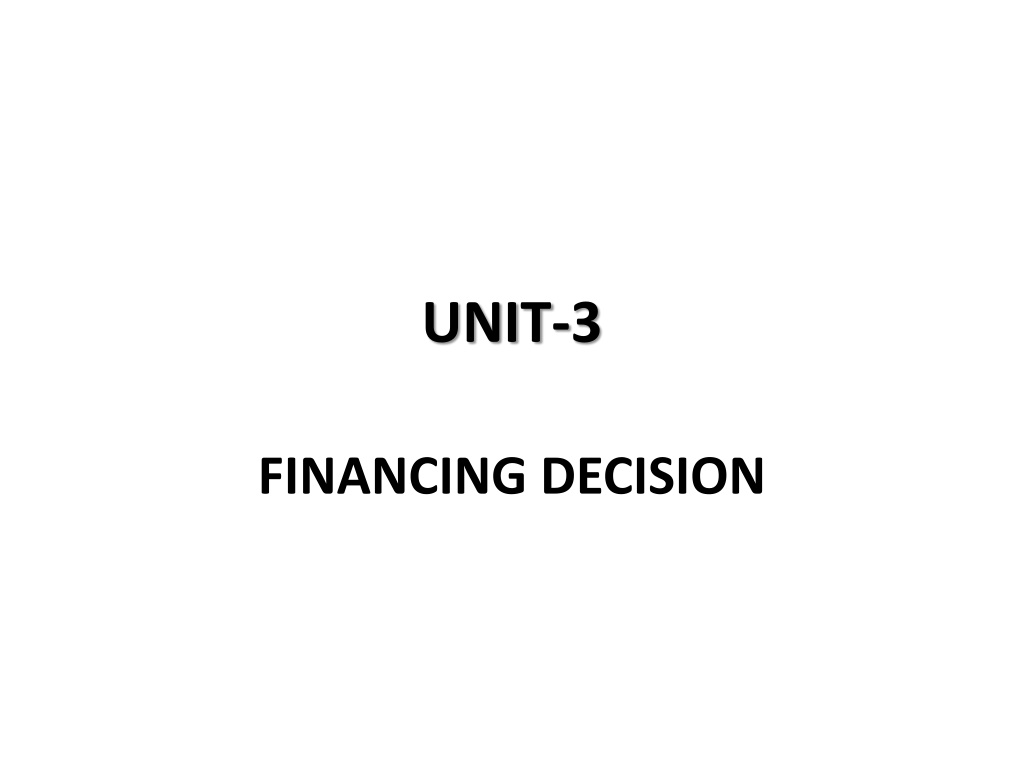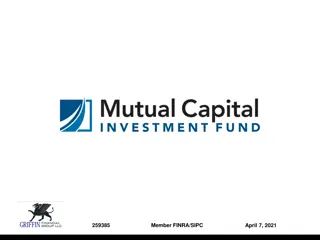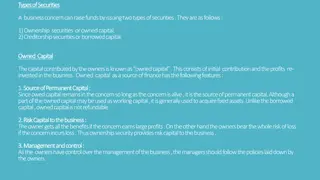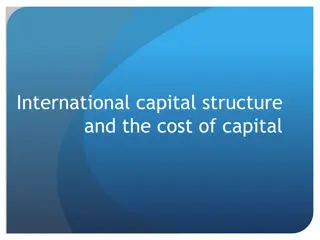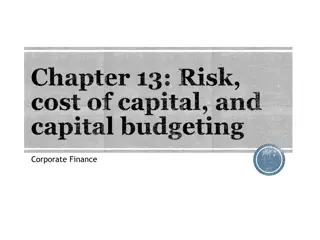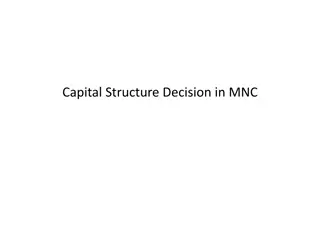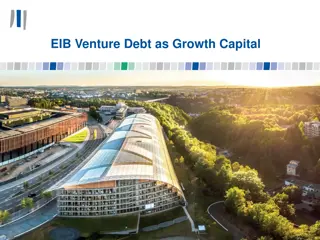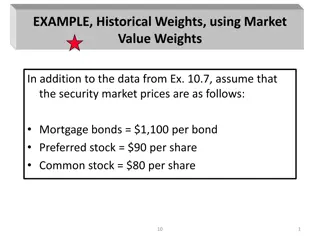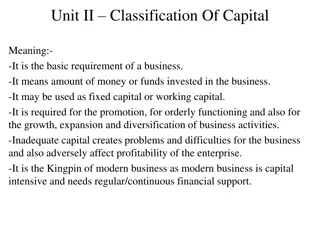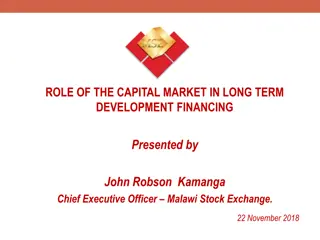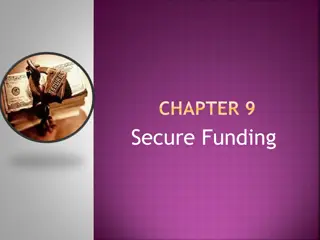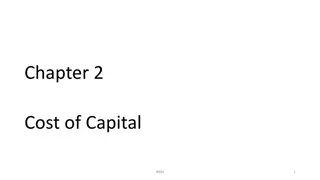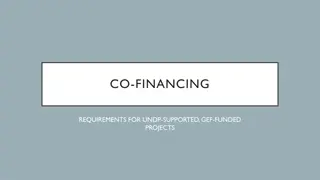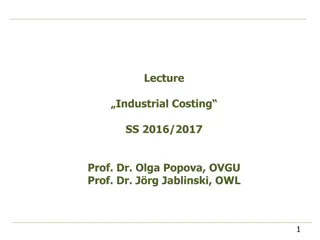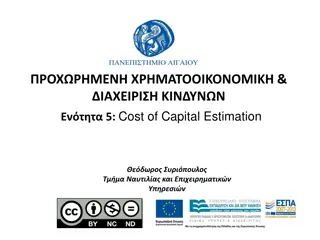Financing Decision and Cost of Capital in Business
Explore the interdependence and inter-relationship between investment and financing decisions, including managing the debt-equity mix for optimal capital structure. Learn about the concepts and measurement of cost of capital, operating and financial leverage, and planning capital structure. Delve into the features of debt instruments, such as fixed financial obligations and the tax benefits of interest expenses. Practice calculating the cost of debt in different scenarios, considering factors like redemption value, sale value, and tax rates.
Uploaded on Oct 03, 2024 | 3 Views
Download Presentation

Please find below an Image/Link to download the presentation.
The content on the website is provided AS IS for your information and personal use only. It may not be sold, licensed, or shared on other websites without obtaining consent from the author.If you encounter any issues during the download, it is possible that the publisher has removed the file from their server.
You are allowed to download the files provided on this website for personal or commercial use, subject to the condition that they are used lawfully. All files are the property of their respective owners.
The content on the website is provided AS IS for your information and personal use only. It may not be sold, licensed, or shared on other websites without obtaining consent from the author.
E N D
Presentation Transcript
UNIT-3 FINANCING DECISION
Interdependence & inter-relationship Investment decision Financing decision (DEBT-EQUITY MIX)
FINANCING DECISION/ CAPITAL STRUCTURE COST OF CAPITAL EARNINGS &VALUATION (MINIMISE) RISK (MAXIMISE) Concept & Measurement of Cost of Capital Operating, Financial and Combined Leverage Capital structure, cost of capital and valuation Planning and designing of Capital structure
Cost of Capital Discount rate Required rate of return Hurdle rate/ cut-off/bench mark Weighted average cost of capital(WACC)
Cost of DEBT Features of a debt instrument: Fixed financial obligation No share in profit Creditors of the company Cant participate in management Interest is a tax-deductible expense/tax- shield
Cost of Debt Redeemable debt Irredeemable debt: 150 10 ..10 .10 10 PV = A/r = 100 = 10/r =100; r = 10/150 ??=I/SV = 10/150 = .066 = 6.6% PV of this series = amount/r ??=I(1- t)/SV = 10(1-.2)/150 =.053 = 5.3%
Redeemable debt 100 ..10 ..10 ..10 ..10 ..110 100 = 10/ (? + ?)?+ 10 ? + ??+10/ (? + ?)? +10/ (? + ?)?+ 110/ (? + ?)? Short cut formula Short cut formula ??=I(1- t) + (RV-SV)/Nm/(RV+SV)/2 Where RV = Redemption value SV = Sale value & I =Amt of Interest ??=I(1 t) + (f+ di+ Pr Pi)/Nm/(RV+SV)/2
Practice problems A company issues 16% debentures of Rs. 1000 face value to be redeemed after 10 years. The debenture is expected to be sold at 3% discount. It will also involve floatation cost of 1.5%. The company s tax rate is 35%. Find the cost of debt? ??=I(1- t) + (RV-SV)/Nm/(RV+SV)/2 SV or NP = 1000- 30 -15 =955 ??=???(1- .35) + (1000-955)/10/(1000+955)/2 ??=11.09% ??=160 160(1 .35) + (15+ 30)/10/(1000+955)/2
Practice problems X Ltd, issued irredeemable/ perpetual debentures of Rs 5,00,000 carrying interest rate of 14%. The company is in 35%tax bracket. Find the cost of debt (before tax & after tax) in the following situations: When debentures are issued at par= 70,000/5,00,000=14% & 14(1-.35)=9.1% When debentures are issued at discount of 15%=70,000/4,25,000=16.47% & 16.47(1-.35)=10.71% When debentures are issued at premium of 15%= 70,000/5,75,000 = 12.17% & 12.17(1-.35) = 7.91%
Redeemable in installments A company issued 10% debentures aggregating Rs. 1,00,000. The floatation cost is 5%.the company has agreed to repay the debentures at par in 5 equal annual installments starting at the end of year 1. The company s rate of tax is 50%. Find the cost of debt. Solution: Cash-inflow =1,00,000-5,000=95,000 Fake PB = Initial Cash-inflow/Avg CFAT 95,000/23,000 =4.13(A4)
Solution YEAR Principal Interest After tax int. CFAT PVIF@7% PV CFAT 1 20,000 10,000 5,000 25,000 .935 23,375 2 20,000 8000 4000 24,000 .873 20,952 3 20.000 6000 3000 23,000 .816 18,768 4 20,000 4000 2000 22,000 .763 16.786 5 20,000 2000 1000 21,000 .713 14,973 94,854
At 7% = 94,854 -95,000 = (146) At 6% = 97,366 95,000 = 2,366 ??= r +[ NPVr/NPVrL - NPVrH] * r ??= 6 +[ 2,366/2,366 + 146] *1 ??= 6.94%
Debt is the cheapest source of finance Expectation of return depends on the amount of risk taken by investor. And risk is variation in return. Expectation of return determines the cost of fund. Assured and regular income from interest, investors expect minimum return Assured redemption at the time of liquidation. Interest is a tax- deductible expense: tax- shield
Cost of Preference share capital Hybrid kind of source/fund Fixed amount of dividend No ownership rights Preferential rights over equity for the payment of dividend and redemption of capital Not tax-deductible payment.
Cost of Preference share capital Irredeemable preference share capital Redeemable preference share capital Is that rate of discount which equate the present value of all dividends with the sale value Irredeemable: ??=?/SV D = Amount of dividend SV = NP =Net proceeds/ sale value
Redeemable preference share capital 100 ..12 ..12 .12 .12 12 112 Is that rate of discount which equate the present value of all dividends with the sale value Short-cut formula: ??=? + (RV-SV)/Nm/(RV+SV)/2
Practice problems A company issues preference share(face value =100) carrying 16% rate of dividend and maturity period of 10 years. The floatation cost involved in the issue is 2%. The preference will be redeemed at par after 10 years. Find the cost of preference shares. ??=d d+ (f+ di+ Pr Pi)/Nm/(RV+SV)/2 ??=16 16+ (2)/10/(100+98)/2= 16.36%
Practice problems A company issues 16 % irredeemable preference shares having face value of Rs 100 each. Floatation costs are 3% of sale value. Find the cost of preference shares, if preference shares are issued at (i) par value(ii)10% discount and (iii) 10%premium. What will be your answer if dividend tax is assumed to be 10%. (i) 16.49(1+Dt)% (ii)18.32(1+.1)% (iii) 14.99(1.1)%
Cost of equity share capital Ownership capital No fixed amount of dividend Highest risk takers : variation in return is maximum Expectation of return is highest Irredeemable source of funds Cost of equity is decided by the expectations of the fund provider.(Expected dividend) Cost of equity is that rate of return that a company must earn/provide to its shareholders so that value of shares remains unchanged.
Approaches for cost of equity Dividend Approach Earning- price Approach CAPM (Capital Asset Pricing Model) Approach 100 ..expected0 estimated10 12 .0 1 5
Dividend approach Cost of equity is that rate which equate the present value of (Estimated )dividend with net proceeds. Assumptions: (estimated dividend) Constant dividend model: constant amount of dividend 100 .5 5 .5 ..5..5 ..infinity Constant growth model Varied growth model
Constant dividend model: constant amount of dividend 100 .5 5 .5 ..5..5 ..infinity ??=?/NP Constant growth model: 100 .5 .5(1+5%) .5(1+.05)(1+.05) . NP= D1/ (? + ?)?+ D2/ ? + ??+D3/ (? + ?)?+ D4/ (? + ?)?+ D5/ (? + ?)? .
Constant growth rate is g D1= D0(1+g) D2= D1(1+g) = D0(1+g)2 D3= D2(1+g) = D1(1+g)2=D0(1+g)3 D4= D3(1+g) = D2(1+g)2= D1(1+g)3= D0(1+g)4 NP= D0(1+g) / (? + ?)?+ D0(1+g)2/ ? + ?? +D0(1+g)3/(? + ?)?+ D0(1+g)4/ (? + ?)?+ D5/ (? + ?)? .
Constant growth model Common ratio = (1+g)/(1+r) NP = first term/ 1- common ratio NP = D0 (1+g)/r-g = D1/(r-g) ??= (D1/P0 )+ g P0= D1/ (??-g) P3 = D4/(??-g) P5 = D6/(??-g)
Practice Problem A company is contemplating to declare dividend of Rs.20.15 next year. The company has shown growth rate of 6% and currently its shares are being traded at the market price of Rs 125 per share. Find the cost of equity share. Also find the price of the share of the company at the end year2.
Solution ??= D1/P0+g ??= 20.15 /125 + .06 ??= 0.2212 = 22.12% P2= D3/ (??-g) = D1 (1+.06)2 /.2212 -.06 = 140.45
Varied growth model(g1=2%(2yrs),g2=4%(2yrs) &g3=5% forever) NP/P0 = D0(1+g1) / (? + ?)?+ D0(1+g1)2/ ? + ?? +D2(1+g2)/(? + ?)?+ D3(1+g2) / (? + ?)?+ D4(1+g3)/ (? + ?)? . NP/P0 = D0(1+.02)) / (? + ?)?+ D0(1+.02)2/ ? + ?? +D2(1+.04)/(? + ?)?+ D3(1+.04) / (? + ?)?+ D4(1+.05)/ (? + ?)? . P4 = PV(D5 +D6+ D7+D8+ ) P4 = D5/ (??-g) P0 = PV(D1) +PV(D2) +PV(D3) + PV(D4) + PV (P4) 0 .D1 .D2 D3 ..D4 .D5 D6 0 PV PV PV .PV + P4
Practical problem P0=PV(D1 +D2 +D3 + D4+ P4) Q. A Ltd has following track record of dividend payments in the last five years: Year Dividend per share 1(D-4) 14 2(D-3) 14.70 3(D-2) 15.44 4 (D-1) 16.22 5 (D0) 17.02
Practical problem Using the above information, calculate I. Growth rate in dividend II. Cost of outstanding equity share if the current market price is Rs 135 per share III. Cost of new equity shares if the floatation cost is 3%.
solution 1) D5 = D1(1+g)4 17.02 = 14 (1+g)4 (1+g)4 = 1.215 = 5% 2) ??= D1/P0+g ??= 17.02(1+.05) /135 + .05 ??= 18.2% 3) ??= D1/P0 (1-f) +g ??= 17.02(1+.05) /135(1-.03) + .05 18.6%
Varied growth rate X Ltd declares dividend of Rs 2 per share last year. The company to maintain growth rate as per schedule given below: Year Growth rate 1 to 2 10% 3 8% 4 10% 5thonwards 8%
The shareholders expected rate of return is 16%. Advise whether the share is worth buying at Rs.30? Year dividend PVIF@16% PV 1 2(1+.1)=2.2 .862 1.89 2 2.2(1+.1)=2.42 .743 1.79 3 2.42(1+.08)=2. 61 .641 1.67 4 2.61(1+.1)=2.8 7 .552 1.58 TOTAL 6.93
0D1..D2.D3.D4+P4(.D5.D6) P4 = D5/ (??-g) P4 = 2.87(1+.08) / .16- .08) P4 = 38.75 P0= PV(D1)+PV(D2)+PV(D3)+PV(D4)+PV(P4) = 6.93+ PVIF@16%,4 *P4=.552*38.75 = 6.93 +21.39= 28.31 One should not purchase it.
M Ltd is likely to maintain growth rate of 9% for next four years and thereafter a constant rate of 7%. The company declared dividend of Rs 3.50 per share last year. If the shareholders expected rate of return is 16%, would you advise to buy the share at Rs 50? P0 = 44.21 SHOULD NOT BUY
EARNING-PRICE APPROACH Ke= ?/NP Cost of equity/ market price is a function of Earnings available to equity shareholders. Ke= ?/P0 = 1/ P/E Ratio= 1/ P0/E P0= E/Ke E = EPS P/E ratio = P0/E
Capital Asset Pricing Model(CAPM) Pricing(expected) of any capital asset Return (expected) of equity = cost of equity RETURN depends on Risk (i) systematic risk ( ) (ii)unsystematic risk Re = Rf+ (Rm Rf) Ke= Kf+ (Km Kf)
Cost of Retained Earnings Free of cost ? NO implicit cost/ opportunity cost Amount of dividend foregone by the equity shareholders Expectation from retained earnings are same as expectations from equity. Cost of retained earnings = cost of equity Kr = Ke External yield criteria: 5000 -500 =4,500- 500=4000@20% =800 =800/5000 =16%
Cost of retained earnings is always less than cost of equity Kr= Ke(1-T) (1-B) T stands for dividend tax B stands for brokerage cost
Weighted average cost of capital(WACC) = K0 K0 = Wd(Kd) + Wp(Kp) + We( Ke) + Wr(Kr) Types of weights: (i) Historical weights: actual or existing proportions of different sources of funds (a)Book value: as per financial statements (b)(b) Market value weights (ii) Marginal weights: proportion intend to raise
Practice problems S ltd has the following capital structure as on Dec31,2019 Equity Share Capital(60,000 shares of 10 each) 6,00,000 12%Preference share 6,00,000 10% Debentures 3,00,000 Total Capital 15,00,000 The equity shares of the company are quoted at Rs102 and the company is expected to declare a dividend of Rs 9 per share for the next year. The company has registered a dividend growth rate of 5%which is expected to be maintained. Assuming the tax rate applicable to the company at 50%.calculate the Weighted Average Cost of Capital
Solution Kd= I (1-t) = .10(1-.5) = .05 = 5% Ke= D1/P0+ g = 9/102 + .05 = 13.82% Kp= 12% cost Cost of each fund weights Cost*weights Kd .05 3/15=.2 .01 Ke .1382 6/15=.4 .055 Kp .12 6/15 = .4 .048 Total(WACC) .113 =11.3%
Practical problem The capital structure of Falcon Company Ltd as on 31-12-2018 is as follows: Equity share capital: 10,000 shares of Rs 100 each 10,00,000 10%Preference shares of Rs 100 each 4,00,000 12% Debentures 6,00,000 The market price of the company s share is Rs110 and it is expected that a dividend of Rs 10 per share would be declared after one year. The dividend growth rate is 6%. If the company is in 40%tax bracket, calculate weighted average cost of capital. The company needs to borrow a fund of Rs.10 Lacs for its expansion plan, the rate of interest is 14%, what will be the company s revised weighted average cost of capital? This financing decision is expected to increase dividend from Rs 10 to Rs 12 per share. However, the market price of equity share is expected to decline from Rs 110 to Rs 105 per share.
Solution Kd= I (1-t) = .12(1-.4) = .072 = 7.2% Ke= D1/P0+ g = 10/110 + .06 = 15.09% Kp= 10%, Book value weights: Cost Weights Cost* weights Kd .072 6/20= .3 .0216 Ke .1509 10/20=.5 .075 Kp .10 4/20 = .2 .02 Total(WACC) .1166=11.66%
Market value weights Cost weights Cost*weights Kd Ke Kp Total(WACC) .072 6/21= .28 .02016 .1509 11/21=.52 .07847 .10 4/21=.19 .019 .1176=11.76%
Expansion plan of 10,00,000 Klt= I (1-t) = .14(1-.4) = .084 = 8.4% Ke= D1/P0+ g = 12/105 + .06 = 17.43% Kp= 10%, Book value weights: Value cost weights Cost*weights Kd 6,00,000 .072 6/30 =.2 .0144 Ke 10,00,000 .1743 10/30=.333 .0575 Kp 4,00,000 .10 4/30=.133 .013 LT Loan 10,00,000 .084 10/30=.333 .02772 total 30,00,000 .1126=11.26%
Practical problem of retained earnings A Company has following amount and specific cost of each type of capital. Type of Capital Book Value Market value Specific Cost Preference share 2,00,000 2,50,000 10% Equity shares 10,00,000 18,00,000 15% Retained earnings 2,00,000 ----- ------ debt 5,00,000 7,20,000 8%
Solution Determine the Weighted average cost of capital using (a) book value weights(b)Market value weights. Type of capital Book value weights cost Weights*cost Preference 2,00,000 2/19=.1052 .10 .0105 Equity 10,00,000 10/19=.526 .15 .0789 Retained 2,00,000 2/19=.1052 .15 .0157 debt 5,00,000 5/19=.2631 .08 .0210 total 19,00,000 .1261=12.61%
Market value weights Type of capital Market value weights cost Weights*cost Preference 2,50,000 25/277=.0902 .10 Equity 15,00,000 150/277=.5415 .15 Retained 3,00,000 30/277=.1083 .15 debt 7,20,000 72/277=.2599 .08 total 27,70,000 12.70%
Exam problem-2004 From the following information, calculate average cost of capital(WACC) before tax for ABC Ltd: Shareholders funds: Rs in Lacs equity 500 preference 100 reserves 300 Borrowed Funds: Secured loans 800 unsecured loans(including intercorporate deposits) 700 Total funds 2400 Additional information: (i) Normal yield on equity shareholders fund is 15% (ii) Dividend rate on preference shares 12% (iii)Interest on secured loans is 16.25% (iv) Interest on unsecured loans is 20% (iv)Tax rate for ABC Ltd is 40%
